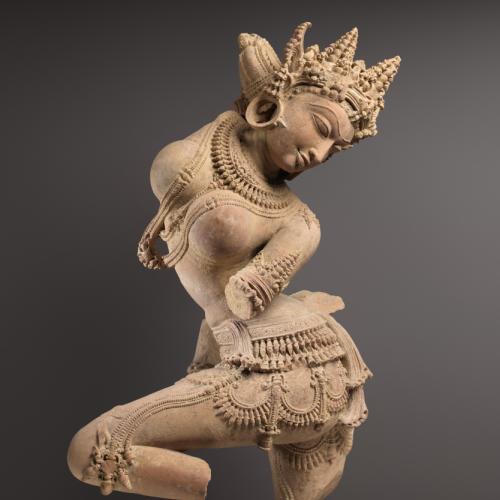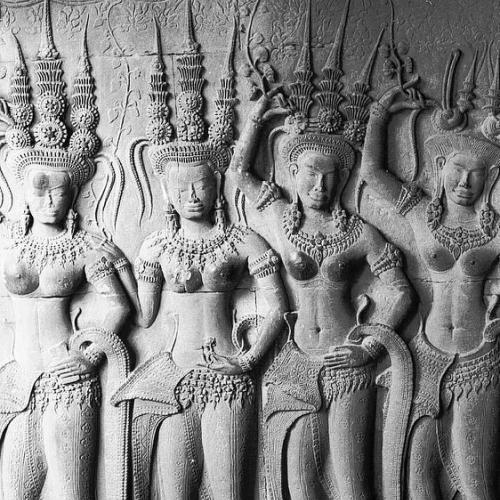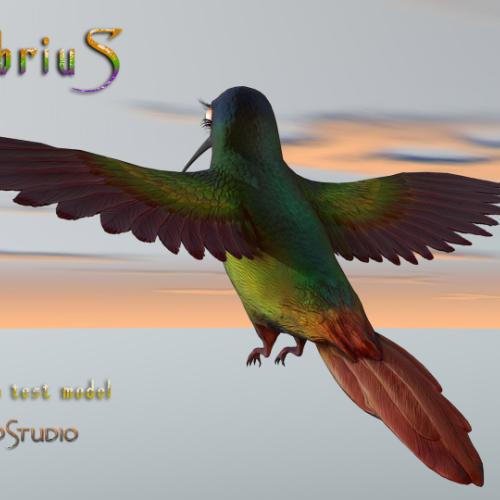In Hindu mythology, the Apsaras are nymphs.
Originating in Central Asia and the Indus Valley, Hinduism is the world's oldest religion.
Centuries apart and in very different places, the similarity with Greek mythology is uncanny.
Have Zeus and Indra ever met?
Indra is the king of all the gods and the most powerful of them all, like Zeus, his counterpart on Olympus.
Indra is the god of the sky, lightning, the atmosphere, storms and rain, and is also considered the god of fertility through the water he brings to the earth.
He occupied an important place in the Hindu pantheon, but gradually lost his dominant position to Vishnu and Shiva.
Odysseus' adventures with Kirke, Calypso and Nausicaa could well have been written in Sanskrit, as these Greek and Hindu mythical characters transgress the rules imposed on mere mortals by approaching the gods and, in the same liberating movement, free themselves from social and sometimes moral barriers.
The Indo-European language, from the Indo-Aryan family, is still spoken in a few villages by a minority.
India claims Sanskrit as proof of the durability of its culture.
However, it now appears that the oldest traces of this so-called "dead" language can be found northeast of...Damascus, in Syria. (It will be "dead" when no one speaks or writes it - which is not the case).
The Greek myth of Kirke, of oriental origin, already existed in Babylon in the 18th and 17th centuries BC (the epic of Gilgamesh - go to : 5- Kirke the nymph magician, why give in to a mere mortal?)
The porosity of ideological and religious frontiers, following the great trade routes between Asia, the East and the Mediterranean West, is now re-emerging.
"Linking Xi'an, the ancient Chinese imperial capital of the Han dynasty, to ancient Rome from the early 2nd century B.C., then gradually abandoned after Europe opened up the spice route, the "Silk Road" as it was christened by German geographer Ferdinand von Richthofen in the 19th century, is a network of land and sea trade routes linking Asia, Africa and Europe, a bridge between Eastern and Western civilizations, a privileged route for the communication of political, philosophical, cultural and religious ideas, and for the spread of scientific progress. "
(The trade routes and exchanges between East and West from ancient times to today_Call for Papers, Calenda, Published Tuesday March 02, 2021, https://calenda.org/849548).
Did the gods of different faiths already meet in the East to divide up the world, as the major political powers do today?
A G20 before mankind's time?
The comparison stops there.
The masters of our time are no substitute for Zeus and Indra, and have no control over any Apsara.
Apsaras become the companions of kings or particularly deserving heroes.
In which case, as in Homer's Odyssey, if you have the soul of a hero, know that the Apsaras can change form at will, and when they show themselves to you, woe betide anyone who refuses to yield to them.
They'll drive you mad or have you devoured by the wild beasts that obey their voice.
Conversely, their human lovers sometimes win immortality after a series of initiatory trials. As with the Greeks.
Odysseus was united with three nymphs, including Circe, who showed him the way home and also fell in love with him.
But for the other mortals in the Odyssey, companions of the Mycenaean king...none returned.
Not just anyone can be Odysseus.
Mythology in antiquity knew no borders.
West, East, Asia, Americas, Africa, whatever.
Even if these nymphs have a very different social position in mythology from that which results from the confinement of real-world women in immutable castes.
The term "Apsaras" in ancient Sanskrit means "celestial dancers".
The origins of their slow, fluid and sensual dances can be traced back to India.
The myth expresses the fascination generated by their subtle dances, so intense that mortals and divinities alike could not resist their graceful charms.
The dancers cover the walls of the imposing mineral site of Angkor and the ancient city of Angkor Thom. Dazzling.
In fact, the most famous Khmer king of the Angkorian period, Javayarman VII (12th century), is said to have succumbed so much to this celestial lightness that he had more than three thousand Apsara dancers at his court... (the "Bananarama" and "Spice girls" can go put their clothes back on).
The Apsara dance is an essential part of Khmer culture, dating back to the 7th century, and today a traditional dance that is an ambassador of the charm of the Kingdom of Cambodia's ancestral culture.
Reminder: Images and files that open in a secondary window can be downloaded and printed (excluding albums, images included on pages and videos).

Reconstitutions de sites archéologiques - Modélisations & Animations 3D - Musiques – Montages – SFX – Scénarios
Philippe PETRETO
contact@archeostudio.net
MDA n° P584269
All graphics and audio on this site remain the property of archeostudio.net.
Reproduction and distribution prohibited.



.png?t=7c7326d8_7aec_4651_9db0_1692d655847e)














